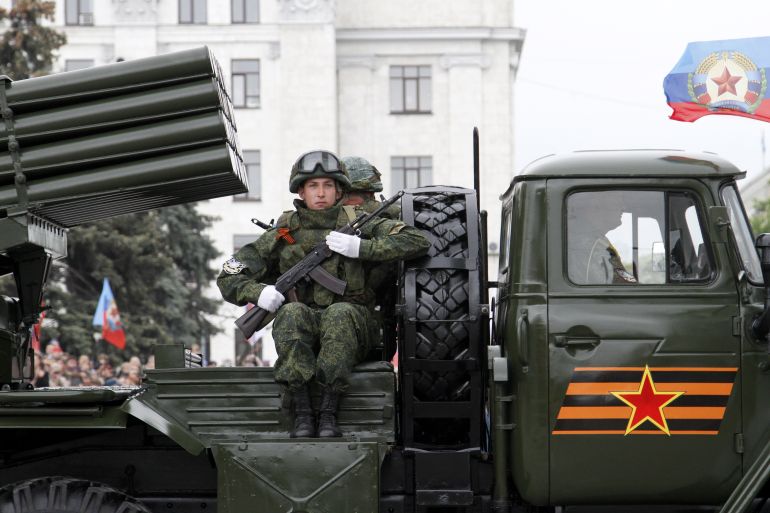Ukraine and rebel region trade shelling allegations
Kyiv and its allies say Moscow could use an incident in the separatist conflict as justification for an invasion.

Ukraine and Russia-backed separatists in an eastern district of Luhansk are trading allegations of an escalation in fighting after the United States claimed that Moscow is seeking a pretext to invade.
The Ukrainian military’s command centre in the east on Thursday alleged that Russian-backed forces fired heavy artillery at the village of Stanytsia-Luhanska “with special cynicism”.
Keep reading
list of 4 itemsPhotos: ‘Unity Day’ held in Ukraine to defy Russia invasion fear
A Russian invasion of Ukraine would be an international crime
Infographic: Russia, Ukraine and the global wheat supply
“The shells hit a kindergarten,” it said, adding two civilians were wounded and public infrastructure damaged. Electricity was also disconnected in parts of the village.
Photographs on the command centre’s Facebook account showed civilians sheltering in a cellar and a kindergarten playroom with rubble strewn on the floor and a shell hole in the wall.
Ukraine’s President Volodymyr Zelenskyy said the pro-Russian forces shelled the kindergarten in what he called a “big provocation”.
‘The Kremlin playbook’
For its part, the Kremlin said Moscow was “seriously concerned” about reports of an escalation after separatists accused government forces of opening fire on their territory four times in the past 24 hours.
British Foreign Secretary Liz Truss tweeted: “Reports of alleged abnormal military activity by Ukraine in Donbass are a blatant attempt by the Russian government to fabricate pretexts for invasion. This is straight out of the Kremlin playbook.”
Ukraine’s Foreign Minister Dmytro Kuleba did not mention any injuries but condemned the alleged shelling.
“We call on all partners to swiftly condemn this severe violation of Minsk agreements by Russia amid an already tense security situation,” he said, referring to a 2014 international accord supposed to halt the war.
Kurt Volker, a former US ambassador to NATO, said “absolutely” NATO’s concerns about an alleged pretext operation should be taken seriously.
“This is something Russia has done consistently during its eight-year occupation of parts of Donbas. Whenever it wants to raise tension or put pressure on Ukraine, it claims that Ukraine has fired on its troops. It’s something that Russia does with regularity. It is apparent that is happening now,” Volker told Al Jazeera.
Russian news agencies, meanwhile, reported the separatist forces in Luhansk claimed the Ukraine military escalated fighting.
“Over the past 24 hours, the situation on the line of contact has escalated significantly,” Yan Leshchenko, head of the People’s Militia in the self-declared Luhansk republic, told reporters.
“The enemy, on the direct orders of the Kyiv military-political leadership, is making attempts to escalate the conflict.”
34 incidents reported
In Moscow, Kremlin spokesman Dmitry Peskov described the allegation of a Ukrainian escalation as “disturbing”.
“This is a matter of very deep concern,” he said. “We hope that our opponents from Western capitals, from Washington, from NATO, will use all their influence to warn the Kyiv authorities against further escalation.”
Al Jazeera’s Andrew Simmons, reporting from Kyiv, said firing mortars, grenade launchers and machineguns, as it was claimed, is in contravention to the Minsk Protocol, an agreement that sought to end the war in the Donbas region.
Simmons said 34 incidents of violence were reported by the Ukrainian government in several cities on Thursday.
While skirmishes are common, tensions at the border are high as Ukraine and its Western allies say Russia has deployed a huge potential invasion force. US intelligence has accused Moscow of seeking to create a pretext by faking an atrocity.
NATO says more than 100,000 Russian soldiers are on the border, but Moscow insists it is seeking a diplomatic route to resolve its security concerns and roll back the West’s influence in Eastern Europe.